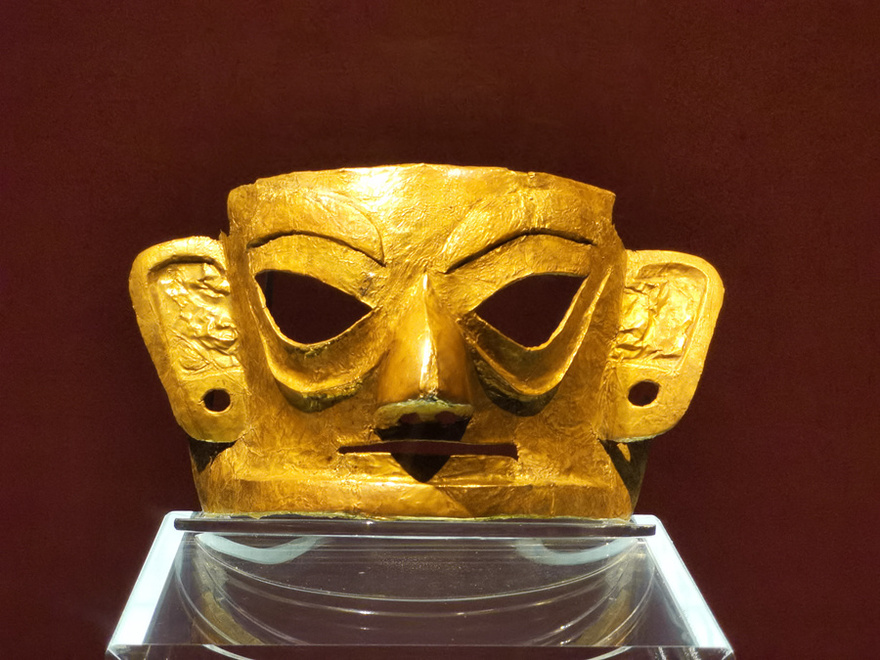
A gold mask on display in the Jinsha Site Museum in Chengdu, Sichuan province. [Photo provided to China Daily]
Exhibition highlights ancient artifacts that shed light on the emergence of Chinese civilization, Huang Zhiling and Tao Xiaoli report in Chengdu.
Shen Zaiwang, a senior interpreter with the Sichuan Provincial People's Association for Friendship with Foreign Countries, recently paid a visit to the Jinsha Site Museum in the Sichuan provincial capital of Chengdu.
At the museum, he viewed 183 ancient cultural relics from Syria which are on the second leg of a one-year China tour. The exhibition will last until May 8.
The relics include daily-use items, ceremonial utensils, portrait sculptures and architectural decorations. A highlight of the exhibition is a stone hand axe dating back between 300,000 and 500,000 years.
Shen marveled at both the splendor of the ancient Syrian civilization and the scarcity of visitors to the 30.4-hectare garden-like Jinsha Site Museum, located just 5 kilometers from downtown Chengdu.
However, there have been large crowds at the Sanxingdui Museum 40 kilometers away, following a live broadcast of relics excavated from six newly discovered sacrificial pits in the Sanxingdui Ruins (where the Sanxingdui Museum is located) in March.
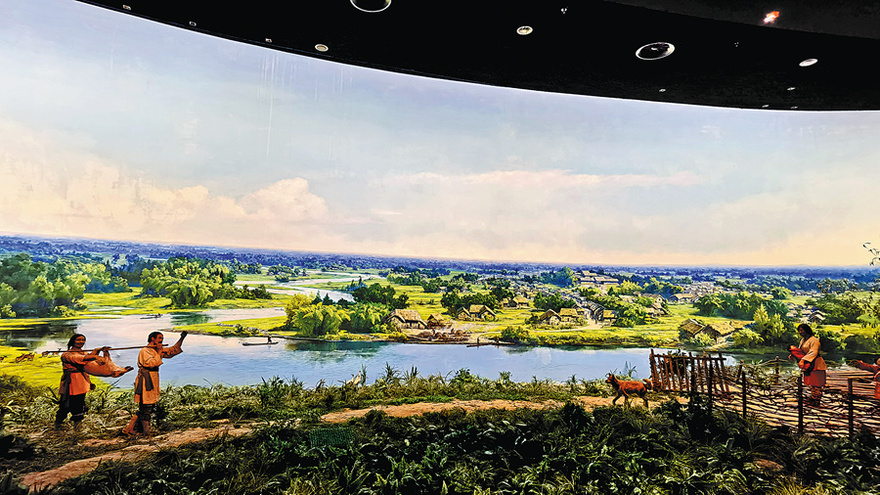
A painting in the museum's Exhibition Hall No 1 depicts inhabitants of the Jinsha Ruins 3,000 years ago. [Photo provided to China Daily]
According to Luo Shan, a young woman working as a receptionist in the Sanxingdui Museum in Guanghan, Sichuan, the site has been inundated with visitors and there aren't enough guides to show them around.
As a matter of fact, the Sanxingdui Ruins and Jinsha Ruins are closely related. Zhu Zhangyi, curator of the Jinsha Site Museum, says: "The National Cultural Heritage Administration is promoting their joint application for inclusion on the UNESCO World Heritage List."
The Jinsha Ruins are most likely to be the political and cultural center to which the ancient Shu (ancient name for Sichuan) Kingdom moved from Sanxingdui about 3,000 years ago, says Zhu, who has been an archaeologist since his participation in the excavation of the No 1 and No 2 pits of the Sanxingdui Ruins in 1986.
Archaeologists have conducted excavations at the site since the 1930s, following the discovery of the Sanxingdui Ruins in 1929 by a farmer digging a ditch in his fields.
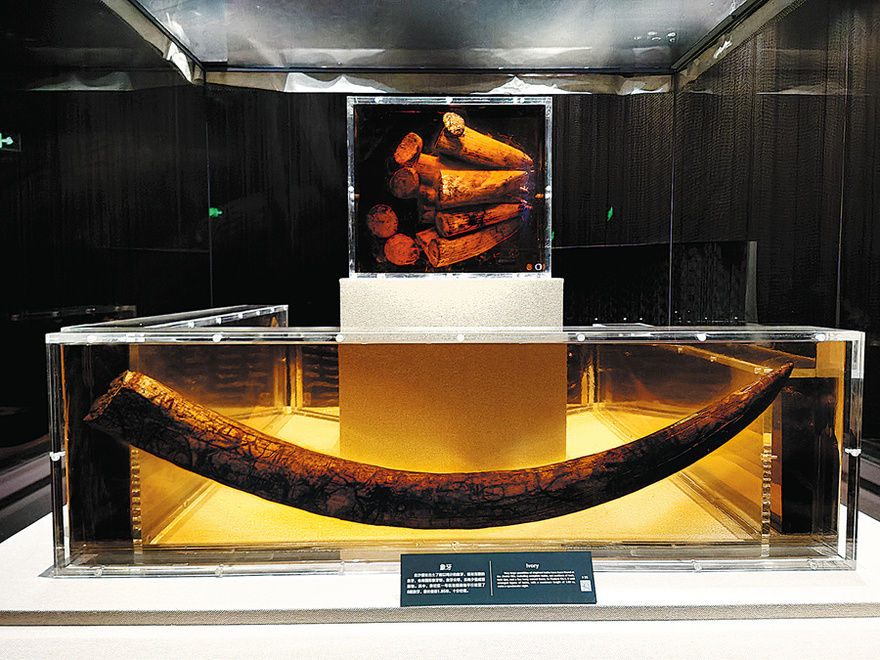
Elephant tusks unearthed from the Jinsha Ruins are also on display. [Photo provided to China Daily]
Findings confirmed that the Sanxingdui Ruins, established between 2,800 and 4,800 years ago, also housed the ruins of an ancient city that was the political, economic and cultural center of the Shu Kingdom.
One of China's most important archaeological discoveries of the 20th century, the Sanxingdui Ruins, located on the upper reaches of the Yangtze River, is also convincing proof that the origins of Chinese civilization are diverse, as it scotches theories that the Yellow River is the sole origin, according to Duan Yu, a historian with the Sichuan Provincial Academy of Social Sciences.
The Jinsha Ruins, where the Jinsha Site Museum is located, cover 5 square kilometers including an area for holding sacrificial rites, residential quarters for the nobility, a residential complex for commoners and a graveyard.
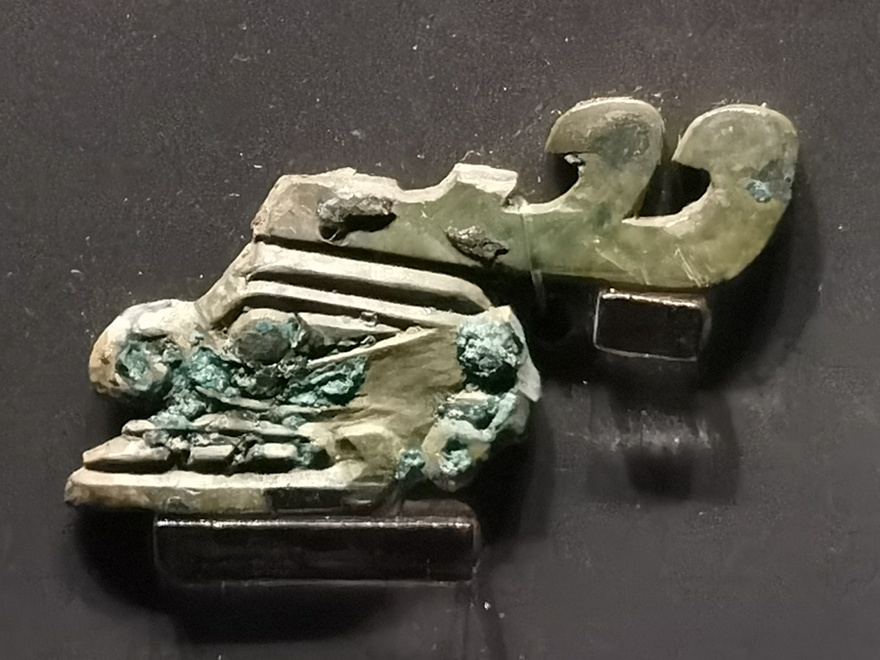
A jade god-man sculpture from the Jinsha Ruins shown at the museum. [Photo provided to China Daily]
Archaeologists hail the Jinsha Ruins as one of Sichuan's most important archaeological findings since the discovery of the Sanxingdui Ruins.
Like Sanxingdui, Jinsha was discovered by accident.
On Feb 8, 2001, builders working on an apartment construction site in Jinsha village found ivory and jade pieces among piles of earth.
Since then, archaeologists have excavated more than 10,000 precious relics including gold, jade, bronze and stone wares as well as one metric ton of whole elephant tusks and tens of thousands of pottery and ceramic shards.
Jinsha is known as one of China's most prolific excavations in terms of gold and number of artifacts unearthed. It's also one of the world's largest excavations of ancient elephant tusks, Zhu says.
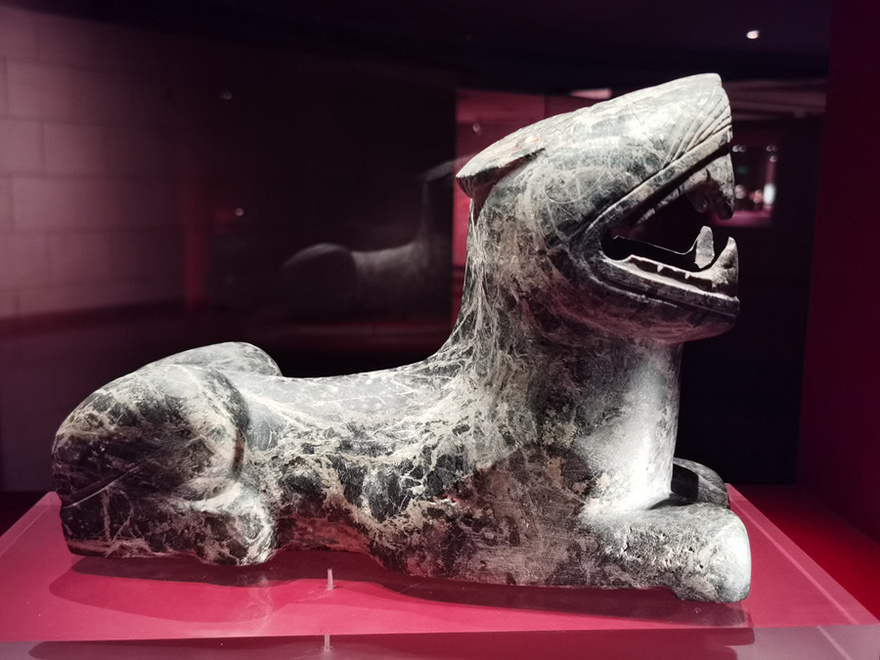
A stone tiger excavated from the Jinsha Ruins displayed at the Jinsha Site Museum. [Photo provided to China Daily]
Archaeologists made a comprehensive analysis of the relics from the Sanxingdui and Jinsha ruins, including gold, bronze, jade, stone, ivory and pottery, and they found similarities in type, shape and processing techniques.
Unearthed at the Jinsha site, a 44-gram gold band, which is 19.9 centimeters in diameter when circled, 2.8 cm wide and 0.02 cm thick, is now on display in Exhibition Hall No 4 at the site's museum.
The band has four identical groups of patterns, each with a human head, an arrow, a bird and a fish; it shows a man shooting an arrow past one side of the bird and into the head of the fish.
As a counterpart to the band, a gold cane unearthed from the No 1 pit of the Sanxingdui Ruins also has symmetrical groups of patterns featuring a human head, arrow, bird and fish, in the same style.
Zhu says: "The gold cane is similar to a pharaoh's mace in ancient Egypt, and the gold band is like the crown. They both symbolize supreme power. The patterns on the gold band and cane signify the identity, or continuity, of the rulers in Sanxingdui and Jinsha. The Jinsha site might be a new capital for ancient Shu tribes after the decline of the kingdom in Sanxingdui."
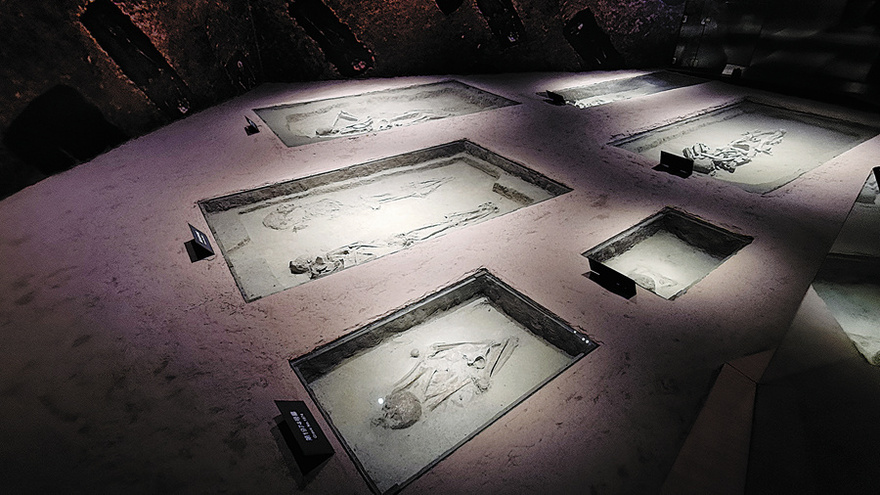
Graves unearthed at the Jinsha Ruins are shown in the Jinsha Site Museum. [Photo provided to China Daily]
Unearthed in the Jinsha Ruins, a 14.6-cm standing bronze figure is on display in Exhibition Hall No 3 at the Jinsha Site Museum.
The figure is highly similar to the 180-cm-tall standing bronze figure found in the No 2 pit of the Sanxingdui Ruins.
Although there is nothing in their fists, both figures seem to be holding something and are standing as if presiding over a holy and important ceremony. They both have a square face and a hole in the earlobe.
Researchers think that both bronze figures might represent the chief sorcerer or the king of the ancient Shu Kingdom, or both.
In an obscure corner of Exhibition Hall No 3 at the Jinsha Site Museum, a jade god-man head sculpture looks similar to a piece unearthed at the Sanxingdui Ruins.
With a height of 2.3 cm, a width of 3.4 cm and a thickness of 0.26 cm, this jade object shows the profile of a god-man head. Wearing a decorative hat, the ferocious image has a long eyebrow, a triangle eye, a crooked nose, and a big mouth revealing three teeth. The lower end of this object was broken; researchers presume that it should have a long neck, to be fixed on a certain article as a decoration.
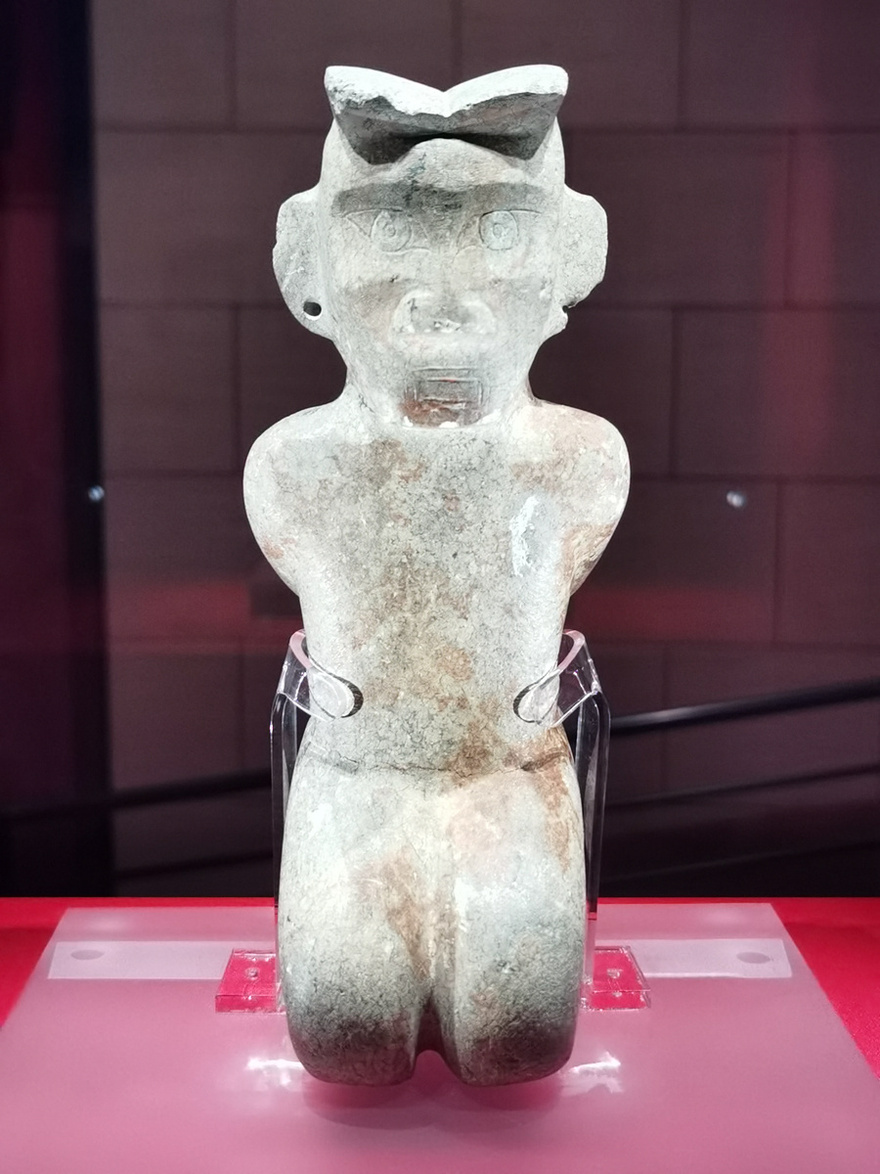
A kneeling stone human figure unearthed at the Jinsha Ruins is on show in the museum. [Photo provided to China Daily]
The style of this god-man sculpture is almost identical with that of a human head profile found in the No 2 pit of the Sanxingdui Ruins, and similar to that of a large bronze animal mask unearthed from the same pit.
The identical style of this jade sculpture from the Jinsha Ruins and the human head profile from the Sanxingdui Ruins indicates the close links between the two sites, researchers say.
Like the Sanxingdui Museum whose exhibits are mainly from sacrificial pits of the Sanxingdui Ruins, most of the exhibits in the Jinsha Site Museum are from the area for holding sacrificial rites. Historical records show that in ancient China, sacrifice and war were the most important state affairs.
Although the Jinsha Site Museum does not seem to be a very hot tourist destination, most of the time being of interest only to history buffs like Shen, it has received 16 million visitors since it opened in 2007, according to Zhu.
In addition to its regular exhibits, the museum arranges unique temporary exhibitions, like the present Syrian cultural relic exhibition. Many of the temporary exhibitions span the Spring Festival and are a big draw for locals.
Contact the writers at huangzhiling@chinadaily.com.cn
If you go
Jinsha Site Museum
8 am-6 pm
2 Jinsha Yizhi Lu, Chengdu, Sichuan province
Tel: 028-8730-3522
Admission: 70 yuan
Copyright ©1997- by CRI Online All rights reserved